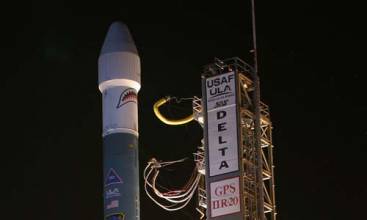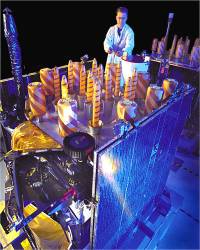 GPS satellite L-band antenna elements
GPS satellite L-band antenna elementsThe GPS Wing is reaching out to receiver manufacturers and the user community to gather comments on the SVN49 signal anomaly and the Air Force’s provisional solution to the problem.
Despite earlier news reports suggesting that the problem, which has kept the latest GPS satellite from being declared operational, was on its way to being solved, a GPS Wing spokesperson characterized the remedy of altering the satellite’s broadcast orbital position (ephemeris) and time as only a “partial fix.” Indeed, high-precision dual-frequency users, such as those in the International GNSS Service, may continue to encounter difficulties in handling the SVN49 signal.
The GPS Wing is reaching out to receiver manufacturers and the user community to gather comments on the SVN49 signal anomaly and the Air Force’s provisional solution to the problem.
Despite earlier news reports suggesting that the problem, which has kept the latest GPS satellite from being declared operational, was on its way to being solved, a GPS Wing spokesperson characterized the remedy of altering the satellite’s broadcast orbital position (ephemeris) and time as only a “partial fix.” Indeed, high-precision dual-frequency users, such as those in the International GNSS Service, may continue to encounter difficulties in handling the SVN49 signal.
First detected April 10, the anomaly is caused by a signal being reflected from a filter into an auxiliary port through which the new L5 demonstration signal travels. The resulting multipath effect is producing higher than normal pseudorange errors, particularly noticeable on L1 signals, that vary with the elevation of the satellite in the sky.
An article by authors at the European Space Operations Center (ESOC) to appear in the forthcoming issue of Inside GNSS (and now available on our website) describes the nature of the anomaly and the effects of Air Force efforts thus far to correct it, as well ESOC’s own method for overcoming the resulting problems.
The GPS Wing has engaged GNSS navigation consultant Tom Stansell to develop a presentation that explains the problem and its effects and to conduct interviews with user equipment manufacturers and other organizations in order to get their perspectives on the problem and possible solutions.
According to the presentation released by the Wing, under normal operation the antenna coupler and array are designed to shape the radiated power from J1 to provide as uniform a signal power density over the Earth as possible.
An inner ring of four antenna elements transmits most of the L1 and L2 power from J1 with a broad pattern. An outer ring of eight elements transmits a sharper pattern, but with a weaker signal.
At higher elevation angles, the outer ring transmits the signal in the opposite phase in order to reduce the radiated power. Otherwise, the signal power would be too strong at high elevation angles and not strong enough at low angles.
However, modifications made in the course of installing an L5 demonstration payload on the Block IIR-M(20) satellite — designated SVN49 once it was in orbit —allows some of the L1 and L2 signals to exit through an auxiliary port (J2) rather than the intended J1 port.
This portion of the signal is reflected from the L5 filter and then transmitted from the J2 port with 30-nanosecond delay —. Most of the power from J2 goes to the outer ring of elements in the transmit antenna with less going to the inner ring — the inverse power distribution from J1.
As a result, much weaker, delayed, L1 and L2 signals are transmitted from the J2 port. The pattern has a null at moderate angles; so, polarity reverses between low and high elevation angles.
This situation effectively creates a multipath signal with about a 30-nanosecond delay and signal power that is 14 to 38 decibels weaker than the direct signal, depending on the satellite elevation. This delay is smaller than that which can be handled by the correlator spacing in most GPS receivers, causing a code correlation error that in turn creates substantial signal-tracking problems and position errors.
In order to reduce the elevation-dependent tracking residuals, the 2nd Space Operations Squadron (2SOPS) in the GPS Master Control Station at Schriever Air Force Base, Colorado, has experimented with placing the antenna phase center about 152 meters above the satellite rather than slightly below as normal.
A Kalman filter in the satellite’s navigation payload then provides orbit and clock parameters that best fit the tracking data. Over the next few weeks, 2SOPS will experiment with different values transmitted in the navigation messages.
Further complicating the situation are differences in the ways that various receiver manufacturers implement their equipment’s signal-tracking and positioning. For example, the ESOC researchers reported that two receiver models from Trimble do not show the SVN49 data anomaly or, at least, show it at a much less pronounced level.
Some experts are worried by this different behavior of receivers, however, because developing receiver-dependent corrections to handle the anomaly could create a variety of problems. Moreover, the signal anomaly may not prove to be stable over time, which would complicate both system- and receiver-level solutions.
According to the GPS Wing, GNSS simulator manufacturer Spirent Federal is preparing a scenario, based on the SVN49 error models, to simulate the SVN-49 problem and enable laboratory testing.
The scenario, which will be directly available from Spirent on request, provides normal L1 and L2 signals plus a delayed signal with the proper relative amplitude and phase relationships as a function of elevation angle in accordance with these models.




